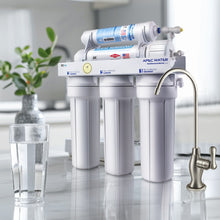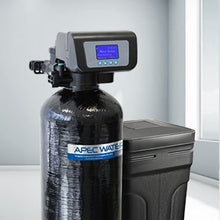Issues With Our Modern Water Supply
Clean Safe Water is no longer a guarantee in today's world. Unfortunately, most of our water supply is now contaminated with microplastics and PFAs (per- and polyfluoroalkyl substances). Both of these contaminants are invisible to the naked eye and resistant to standard municipal filtration.
However, with the right home filtration system, we are better able to purify these microplastics and PFAs from your home's water supply.
The Invisible Problem
Microplastics easily pass through most city water treatment systems because these particles are less than 5 millimeters in size. These contaminants come from degraded plastic waste, synthetic fibers, and even household products. Over time, these microplastics have become so widespread that oceans, rainwater, and even tap water now show signs of microplastic contamination.
PFAs, or "forever chemicals, post a similar thread. PFAs are found in many commonly used products including non-stick pans, waterproof clothing, fire fighting foam and more. Once PFAs enter the water supply or environment, they can stay forever.
Here are somethings to consider:
Size: Both PFAs and microplastics are too small for traditional filters to catch.
Persistence: They don’t biodegrade, meaning they accumulate in the environment and the human body.
Health Impact: Studies link PFAs to hormonal disruption, immune suppression, and certain cancers, while microplastics may carry toxins and cause inflammation.
Two Possible Solutions
Two ways of removing PFAs and microplastics from household water:
Reverse Osmosis (RO) System: An RO system can remove these harmful contaminants and provide pure filtered water.
Whole-House Filtration System : A Whole House system can provide comprehensive home-wide protection by filtering water before it flows throughout the house.
Think of it this way:
The RO system is your “final polish,” ensuring every drop you drink is free from micro-contaminants.
The whole-house system is your “first line of defense,” capturing chemicals, sediments, and particles before they flow into any faucet.
“Perfect Drink” Filter: Reverse Osmosis
If you want the cleanest, safest water for drinking and cooking, reverse osmosis (RO) is the gold standard.
RO systems use a semi-permeable membrane with microscopic pores that block particles as small as 0.0001 microns. These membranes are small enough to remove PFAs, microplastics, heavy metals, and even viruses. As water passes through the membrane, contaminants are flushed away.
What makes RO ideal for PFAs and microplastics?
High selectivity: The membrane effectively separates molecules based on size and charge, blocking “forever chemicals” and microscopic debris.
Improved taste: By removing chlorine, sediment, and dissolved solids, RO water tastes noticeably cleaner and fresher.
Health confidence: It provides a consistent source of water that’s nearly free from chemical and particulate pollution.
View some Reverse Osmosis System Options!
“Whole Home” Shield: Whole-House Filtration
Whole House Water Filtration systems filter the water for the whole house.
Usually these Whole House Water systems are installed at the main water line and enable clean filtered water to flow through your whole home.
Cleaner water for showers, laundry, and dishes, ensure your home's water does not cause as much buildup and scaling and extends the life of your appliances.
For PFAs and microplastics, these systems use multi-stage filtration with activated carbon and sediment filters.
Activated carbon adsorbs PFAs, chlorine, VOCs, and other organic chemicals.
Sediment filters trap larger particles, reducing the overall load before it reaches your RO unit or faucets.
Why it matters:
Safer bathing water: Filtered shower water reduces chemical exposure to skin and body.
Cleaner air: Fewer volatile chemicals means less inhalation during showers or dishwashing.
Less buildup: Clean water prevents scale and residue on fixtures and clothes.
View some APEC Whole House System Options!
FAQs
Q: Can my current water filter pitcher remove microplastics?
Most water filter pitchers can reduce chlorine and improve taste, but their pore sizes are too large to block microplastics or PFAs. For true contaminant removal, look for systems like APEC’s RO-90 or WH-SOLUTION.
Q: Are PFAs and microplastics the same thing?
No. PFAs are synthetic chemicals, while microplastics are tiny fragments of plastic. However, both are small, persistent, and resistant to standard filtration.
Q: Does Reverse Osmosis really work on microplastics?
Yes. RO membranes filter at the molecular level, removing particles much smaller than microplastics.



